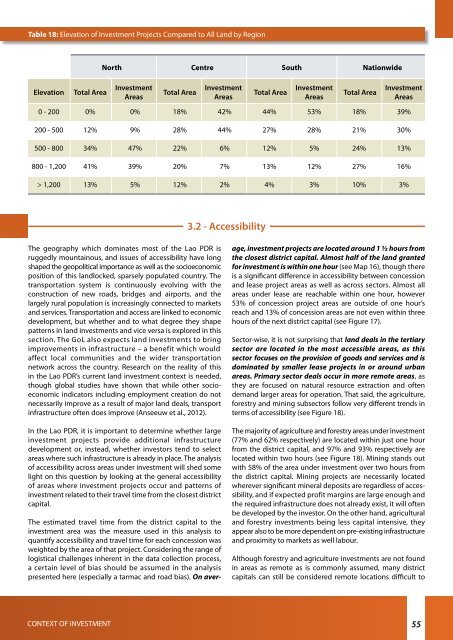Concessions and Leases in the Lao PDR
Concessions and Leases in the Lao PDR
Concessions and Leases in the Lao PDR
You also want an ePaper? Increase the reach of your titles
YUMPU automatically turns print PDFs into web optimized ePapers that Google loves.
Table 18: Elevation of Investment Projects Compared to All L<strong>and</strong> by Region<br />
North<br />
Centre South Nationwide<br />
Investment<br />
Investment<br />
Elevation Total Area Total Area<br />
Total Area<br />
Areas<br />
Areas<br />
Investment<br />
Areas<br />
Total Area<br />
Investment<br />
Areas<br />
0 - 200<br />
0%<br />
0%<br />
18%<br />
42%<br />
44%<br />
53%<br />
18%<br />
39%<br />
200 - 500<br />
12%<br />
9%<br />
28%<br />
44%<br />
27%<br />
28%<br />
21%<br />
30%<br />
500 - 800<br />
34%<br />
47%<br />
22%<br />
6%<br />
12%<br />
5%<br />
24%<br />
13%<br />
800 - 1,200<br />
41%<br />
39%<br />
20%<br />
7%<br />
13%<br />
12%<br />
27%<br />
16%<br />
> 1,200<br />
13%<br />
5%<br />
12%<br />
2%<br />
4%<br />
3%<br />
10%<br />
3%<br />
3.2 - Accessibility<br />
The geography which dom<strong>in</strong>ates most of <strong>the</strong> <strong>Lao</strong> <strong>PDR</strong> is<br />
ruggedly mounta<strong>in</strong>ous, <strong>and</strong> issues of accessibility have long<br />
shaped <strong>the</strong> geopolitical importance as well as <strong>the</strong> socioeconomic<br />
position of this l<strong>and</strong>locked, sparsely populated country. The<br />
transportation system is cont<strong>in</strong>uously evolv<strong>in</strong>g with <strong>the</strong><br />
construction of new roads, bridges <strong>and</strong> airports, <strong>and</strong> <strong>the</strong><br />
largely rural population is <strong>in</strong>creas<strong>in</strong>gly connected to markets<br />
<strong>and</strong> services. Transportation <strong>and</strong> access are l<strong>in</strong>ked to economic<br />
development, but whe<strong>the</strong>r <strong>and</strong> to what degree <strong>the</strong>y shape<br />
patterns <strong>in</strong> l<strong>and</strong> <strong>in</strong>vestments <strong>and</strong> vice versa is explored <strong>in</strong> this<br />
section. The GoL also expects l<strong>and</strong> <strong>in</strong>vestments to br<strong>in</strong>g<br />
improvements <strong>in</strong> <strong>in</strong>frastructure – a benefit which would<br />
affect local communities <strong>and</strong> <strong>the</strong> wider transportation<br />
network across <strong>the</strong> country. Research on <strong>the</strong> reality of this<br />
<strong>in</strong> <strong>the</strong> <strong>Lao</strong> <strong>PDR</strong>’s current l<strong>and</strong> <strong>in</strong>vestment context is needed,<br />
though global studies have shown that while o<strong>the</strong>r socioeconomic<br />
<strong>in</strong>dicators <strong>in</strong>clud<strong>in</strong>g employment creation do not<br />
necessarily improve as a result of major l<strong>and</strong> deals, transport<br />
<strong>in</strong>frastructure often does improve (Anseeuw et al., 2012).<br />
In <strong>the</strong> <strong>Lao</strong> <strong>PDR</strong>, it is important to determ<strong>in</strong>e whe<strong>the</strong>r large<br />
<strong>in</strong>vestment projects provide additional <strong>in</strong>frastructure<br />
development or, <strong>in</strong>stead, whe<strong>the</strong>r <strong>in</strong>vestors tend to select<br />
areas where such <strong>in</strong>frastructure is already <strong>in</strong> place. The analysis<br />
of accessibility across areas under <strong>in</strong>vestment will shed some<br />
light on this question by look<strong>in</strong>g at <strong>the</strong> general accessibility<br />
of areas where <strong>in</strong>vestment projects occur <strong>and</strong> patterns of<br />
<strong>in</strong>vestment related to <strong>the</strong>ir travel time from <strong>the</strong> closest district<br />
capital.<br />
The estimated travel time from <strong>the</strong> district capital to <strong>the</strong><br />
<strong>in</strong>vestment area was <strong>the</strong> measure used <strong>in</strong> this analysis to<br />
quantify accessibility <strong>and</strong> travel time for each concession was<br />
weighted by <strong>the</strong> area of that project. Consider<strong>in</strong>g <strong>the</strong> range of<br />
logistical challenges <strong>in</strong>herent <strong>in</strong> <strong>the</strong> data collection process,<br />
a certa<strong>in</strong> level of bias should be assumed <strong>in</strong> <strong>the</strong> analysis<br />
presented here (especially a tarmac <strong>and</strong> road bias). On average,<br />
<strong>in</strong>vestment projects are located around 1 ½ hours from<br />
<strong>the</strong> closest district capital. Almost half of <strong>the</strong> l<strong>and</strong> granted<br />
for <strong>in</strong>vestment is with<strong>in</strong> one hour (see Map 16), though <strong>the</strong>re<br />
is a significant difference <strong>in</strong> accessibility between concession<br />
<strong>and</strong> lease project areas as well as across sectors. Almost all<br />
areas under lease are reachable with<strong>in</strong> one hour, however<br />
53% of concession project areas are outside of one hour’s<br />
reach <strong>and</strong> 13% of concession areas are not even with<strong>in</strong> three<br />
hours of <strong>the</strong> next district capital (see Figure 17).<br />
Sector-wise, it is not surpris<strong>in</strong>g that l<strong>and</strong> deals <strong>in</strong> <strong>the</strong> tertiary<br />
sector are located <strong>in</strong> <strong>the</strong> most accessible areas, as this<br />
sector focuses on <strong>the</strong> provision of goods <strong>and</strong> services <strong>and</strong> is<br />
dom<strong>in</strong>ated by smaller lease projects <strong>in</strong> or around urban<br />
areas. Primary sector deals occur <strong>in</strong> more remote areas, as<br />
<strong>the</strong>y are focused on natural resource extraction <strong>and</strong> often<br />
dem<strong>and</strong> larger areas for operation. That said, <strong>the</strong> agriculture,<br />
forestry <strong>and</strong> m<strong>in</strong><strong>in</strong>g subsectors follow very different trends <strong>in</strong><br />
terms of accessibility (see Figure 18).<br />
The majority of agriculture <strong>and</strong> forestry areas under <strong>in</strong>vestment<br />
(77% <strong>and</strong> 62% respectively) are located with<strong>in</strong> just one hour<br />
from <strong>the</strong> district capital, <strong>and</strong> 97% <strong>and</strong> 93% respectively are<br />
located with<strong>in</strong> two hours (see Figure 18). M<strong>in</strong><strong>in</strong>g st<strong>and</strong>s out<br />
with 58% of <strong>the</strong> area under <strong>in</strong>vestment over two hours from<br />
<strong>the</strong> district capital. M<strong>in</strong><strong>in</strong>g projects are necessarily located<br />
wherever significant m<strong>in</strong>eral deposits are regardless of accessibility,<br />
<strong>and</strong> if expected profit marg<strong>in</strong>s are large enough <strong>and</strong><br />
<strong>the</strong> required <strong>in</strong>frastructure does not already exist, it will often<br />
be developed by <strong>the</strong> <strong>in</strong>vestor. On <strong>the</strong> o<strong>the</strong>r h<strong>and</strong>, agricultural<br />
<strong>and</strong> forestry <strong>in</strong>vestments be<strong>in</strong>g less capital <strong>in</strong>tensive, <strong>the</strong>y<br />
appear also to be more dependent on pre-exist<strong>in</strong>g <strong>in</strong>frastructure<br />
<strong>and</strong> proximity to markets as well labour.<br />
Although forestry <strong>and</strong> agriculture <strong>in</strong>vestments are not found<br />
<strong>in</strong> areas as remote as is commonly assumed, many district<br />
capitals can still be considered remote locations difficult to<br />
CONTEXT OF INVESTMENT<br />
55

















